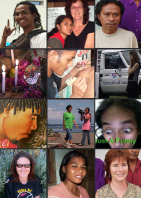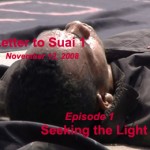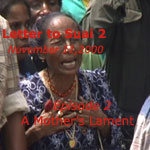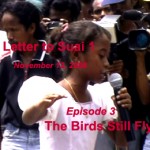Videos showing a re-enactment of the Santa Cruz Massacre at the remembrance ceremony in Dili on 12 November, 2000 is a gift accompanying a ‘Letter to Suai’ from the documentary-maker, dated November 11, 2008. Many people in Suai will see this re-enactment of the massacre for the first time on Suai Media Space.
The letter serves as both an introduction to the videos and a short history of the residents of Port Phillip who worked in solidarity with East Timor for over thirty years and whose actions assisted the people of East Timor get Independence.
Click on the images to go directly to the webisodes and comment.
12 November, 2000.
November 11, 2008
Letter to Suai 1. ‘Seeking the Light’
Dear Friends in Suai – Adriano, Lucinda and Fernando, Sergio, Juliana, Snr and Senora da Costa, Senr and Senora Felix, Ergilio and Simao, Graci and Alberto, the two Lins, Jemi, Tersa, Chamot, Antonio – too many to name,
Today I write to you on Remembrance Day in Australia November 11, 2008. Today our whole country remembers the thousands of young men who died in Europe in World War 2. Tomorrow your whole country will remember the 271 young men and women who died in Dili at the Santa Cruz Cemetry on November 12, 1991. This letter is dedicated to them.
In many ways the friendship that began between our two communities in 2000, following the Suai Church Massacre and the violence that followed your ballot for independence, was made possible by the extraordinary act of sacrifice by your young people in 1991.
When I began reading and researching the history of our countries I noticed that the number of relationships formed between people from Timor Leste and Australia increased each time blood was spilled by Timorese people. When the video tape footage of the Santa Cruz Massacre was on TV in Australia we were able to see the undeniable truth of your situation. We were able to see that the Indonesian colonisation of your country was not benign, but violent and oppressive. As time passed many were then able to realise how deeply we were being deceived by our own leaders in our name.
1975 was the beginning of the violent Indonesian oppression and the seeds of friendship between people in our two communities were planted with blood then – when Greg Shackleton and Tony Stewart were killed in Balibo by the Indonesian military as they invaded your country. Greg’s widow Shirley lives in Port Phillip, and Tony’s brother Paul Stewart lived here. David Scott who helped Ramos Horta escape in 1975 lives in Port Phillip. These three people have been tireless in their support of East Timor since that time. Solidarity Patsy Thatcher, who works as a volunteer for the Friends of Suai began researching the history of World War 2 in East Timor in1981 and became close friends with many Timorese people living in Melbourne as well as some Timorese veterans.
In 1991, many many more people began to support your cause including some people of great influence in your fate who live in Port Phillip and still work to try and ensure a secure future for you. One of these, Bill Armstrong, is Chairman of the Friends of Suai in Port Phillip. Many Timorese refugees came to live in Melbourne and they began working with people in Melbourne. Among these Melbourne people, there are some who live in Port Phillip and I have written about them. Solidarity.
One of those who began working to expose your story to Australians after 1991 was Carmela Baronowska. Carmela is my neighbour, and an independent filmmaker who lives not far from my home. Carmela made a documentary at filmschool that imagined your country getting independence. Carmela was in Timor from early in 1999 filming stories for Australian television that kept us aware of the Indonesian campaign of intimidation and violence against your people that was taking place in the lead up to, and during the ballot. She filmed in the compound in Dili in September alongside our friend HT Lee a photojournalist, who organised a letter of protest to try and prevent the international community of journalists and NGO staff from leaving you unprotected.
It is the work of all of these people and others in the wider Australian community in Melbourne and Sydney that made the mass protest rallies possible in 1999 when we called for the killing to stop, and demanded that our government do what they could to help you. That protest resulted in the forming of Interfet who came in September, 1999. This was a proud moment for all of us in Australia, because our protests were heard, democracy worked and it worked to change your fate and ours. It took too long, and too many lives were lost and damaged, but it did work in the end.
All of us are aware that our freedom and our future is bound up with yours and that is where the passion comes from in so many Australians to walk beside you in your recovery.
I shot the video footage for the episodes in the series ‘Seeking the Light’ in November 2000 when I returned to Dili at the request of Senora Veronica Pereira. Veronica cannot read and write, but she asked friends in Australia to help her and in 1992 she wove five tais with the names of all of the young people who died or disappeared in the Santa Cruz Massacre into them, to record their sacrifice for ever, for history. Veronica asked me to document her journey returning the tais to Timor. And a future letter titled ‘Returning the Tais’ will tell her story.
I am putting this video letter up on the Internet with many others, to remind the people in the world that your young people know what courage is, and as they seek the light, let us hope we can shine some light on them.
Yours sincerely, Jen Hughes












